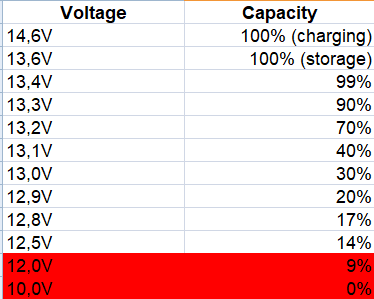Problemy z ogniwami LiFePO4 na oceanie / Problems with LiFePO4 cells on the ocean
 Konsekwencje taniej aplikacji ogniw LiFePo4 do jachtowej instalacji elektrycznej.
Konsekwencje taniej aplikacji ogniw LiFePo4 do jachtowej instalacji elektrycznej.
 Consequences of a low-cost LiFePo4 cell application for a yacht electrical system.
Consequences of a low-cost LiFePo4 cell application for a yacht electrical system.
Pytacie o te nasze problemy z elektryką. Dlaczego nie wypłynęliśmy z Nowej Fundlandii z bateriami LiFePO4 naładowanymi do pełna?
Problem wynikał z przyczyn generalnych: rozłożona w czasie ewolucja instalacji elektrycznej. Zamiast jednego akumulatora kwasowego 100Ah zamontowałem 280Ah w LiFePo4. Wraz z obowiązkowym BMS czyli elektronicznym nadzorcą dbającym o litówki. I tyle. Nasz regulator ładowania z solara jest pod zwykłe akumulatory ołowiano-kwasowe. Podobnie jest z ładowaniem z silnika, ale ten regulator w ogóle jest do wymiany bo szwankuje od początku. A LiFePO4 to zupełnie inna chemia niż kwasiaki i wymaga innego ładowania. Do tego był tylko jeden i to mały (10A) regulator w związku z tym solary były spięte szeregowo. W naszym przypadku prąd maksymalny z solarów był na poziomie 9,5A. Dlatego już zakupione są regulatory "smart" które maja odpowiedni profil ładowania dla litówek i opcje zmiany ustawień. Będę montował je na Kanarach.
Tak naprawdę problemów nie było, po prostu nie mogliśmy wykorzystać pełnego ich potencjału. Dlaczego?
LiFePO4 potrzebuje odpowiednich ładowarek i regulatorów.
Gdybyśmy wszystko od razu dostosowali pod litówki: ładowarki, regulatory itp. to problemów z ładowaniem by nie było. Jak nie wiadomo o co chodzi to chodzi o pieniądze :)
A problem w szczegółach wynika z tego (w uproszczeniu), że kwasiaki i litówki pracują trochę w innym zakresie napięcia. Dla baterii ołowiano-kwasowej 12,9V to full. Dla LiFePO4 to już rozładowanie do 20% nominalnej pojemności. A regulator solara myśli, że bateria jest pełna i ogranicza prąd ładowania. W naszym wypadku przez kilka dni z rzędu w pełnym nowofunladzkim słońcu ładownie było na poziomie 1-1,5A. Malutko. To co podładowało się w dzień zużywaliśmy w nocy na światła, ładowanie telefonów, komputerów itp. Nie mieliśmy opcja korzystania z ładowarki sieciowej, gdyż na nabrzeżu nie było dostępu do sieci. W St. Johns nie ma mariny tylko nabrzeża dla statków. Zresztą w Kanadzie jak i w USA jest siec 110V, którego nasza ładowarka nie obsługiwała.
Wypływając mieliśmy około 64% pojemności czyli 180Ah. W praktyce do wykorzystania było 150Ah. LiFePO4 nie powinny być rozładowywanie poniżej 10%. M.in. przed tym zabezpiecza BMS, który odciął by odbiorniki od ogniw. Teoretycznie mieliśmy prądu na 2,5 doby, gdyż przeciętnie zużywamy około 60-70A dziennie. Zależy to od zafalowania, czyli od tego, jak ciężko pracuje się autopilotowi. W praktyce okazało się, że 5 dnia poziom litówek spadł poniżej 15%, czyli jesteśmy na rezerwie. Wychodzi z bilansu, że solary dały nam w tym czasie około 150A czyli jakieś 30A dziennie. Zabrakło nam 180A by nie tykać steru przez całą drogę. Gdyby baterie były pełne na starcie (dodatkowe 100Ah) to dopłynęlibyśmy do Horty z malutkim zapasem.
Startowy akumulator ołowiano-kwasowy w instalacji LiFePO4 jako bufor i backup.
No i jeszcze backup. Nasz bufor czyli akumulator startowy. Zwykły kwasiak o pojemności 55Ah czyli powiedzmy do wykorzystani około 25A. I korzystaliśmy. Wiem, że dla wielu to rzecz nie do pomyślenia bo bateria startowa silnika to świętość. Ok, może na motorówce czy motosailerze, ale Hultaj to jacht żaglowy. Bardzo żaglowy. I silnik jest tylko napędem pomocniczy, Nie niezbędnym, nie ratującym życie. Od tego mamy żagle. Nie był też niezbędny do wejścia do azorskich portów. W kilku byłem już wcześniej i zawsze wchodziłem na żaglach. Sprawdziłem też parę razy i odpalałem silnik z akumulatora o napieciu 12,2V. Nie było najmniejszego problemu. Gdyby bateria została rozładowana zbyt mocno, wystarczyło by poczekać kilka godzin w dzień, by solar wystarczająco ją doładował. Korzystanie więc z akumulatora rozruchowego nie było więc obarczone żadnym ryzykiem, przynajmniej w tej sytuacji na tym akwenie i w tych warunkach pogodowych. Osobiście jestem lekko przerażony mocno rozpychającą się tendencją, że na jachcie najważniejszy jest silnik. Na który dmuchamy, chuchamy i w gole hołubimy. I nie było by problemu gdyby nie odbywało się to najczęściej kosztem głównego napędu, czyli żagli. Takie podejście sprawiło, że całkiem niedawno pewien duński żeglarz porzucił na morzu swój 48 stopowy jacht i ratował życie ewakuując się na tankowiec.
Ad meritum - w dwie ostatnie doby korzystaliśmy w trybie mieszanym zarówno z litówek (w dzień gdy sterowaliśmy ręcznie) i z baterii startowej w nocy, gdy pracował autopilot. W ostatnią dobę, gdy przepływaliśmy w cieniu wyspy Corvo i spadło zafalowanie, na 2h włączyliśmy silnik, który dał nam około 20A.
LiFePO4 na jacht są super
Czy z perspektywy czasu nadal uważam, że LiFePO4 to dobry pomysł? Tak! Ja z własnej woli do kwasiaków nie wrócę. Mamy 5 razy większą pojemność użytkową akumulatorów. To daje niesamowity komfort. Przy krótszych 2-3 dniowych rejsach korzystamy w kuchni z czajnika elektrycznego (230V 800W), oszczędzając gaz. To wszystko przy mniejszej wadze i objętości.
Już niedługo na pokładzie pojawia się dwa regulatory ładowania solarów. Osobno dla każdego panelu (każdy po 175W). Mają być „smart”, czyli ma się je dać ustawić pod ładowanie LiFePO4 i mogą ze sobą gadać, by pracować synchronicznie, co ma poprawić wydajność ładownia.
Ponieważ kiepski ze mnie teoretyk, za jakiś czas opiszę jak to wszystko sprawuje się w praktyce.

You ask about those electrical problems we've been having. Why didn't we sail out of Newfoundland with LiFePO4 batteries fully charged?
Problem was due to simple reasons: the ‘staggered evolution’ of the electrical system on board of our boat. Instead of a single 100Ah acid battery, I installed 280Ah in LiFePo4. Together with the obligatory BMS, i.e. an electronic ‘supervisor’ taking care of the lithium battery. And that's it.
Our charge controller from the solar is for the regular lead-acid batteries. The same applies to charging from the engine, but this regulator needs to be replaced as it has been failing from the start. LiFePO4 uses a completely different chemical process to acid and requires a different charge. For this there was only one and it was a small (10A) regulator therefore the solar pannel were wired in series. In our case, the maximum current from the solars was at 9.5A. For this reason, we have already purchased "smart" controllers that have the correct charging profile for the lithium batteries and options for changing the settings. I will be installing them on the Canaries.
There weren't really any problems, we just couldn't use their full potential. Why?
LiFePO4 needs the right chargers and regulators.
If we had adapted everything for the lithium right from the start: chargers, regulators, etc. then there would have been no charging problems. When you don't know what's at stake, it's all about money :)
And the problem in the detail comes from the fact (in simple terms) that acid batteries and lithium ones operate in a slightly different voltage range. For a lead-acid battery, 12.9V is full. For a LiFePO4, it's already discharged to 20% of the nominal capacity. The solar controller thinks that the battery is full and limits the charging current. In our case, for several days in a row in full Newfoundland sunshine the charge was at 1-1.5A. Tiny indeed. What charged during the day we used at night for lights, charging phones, computers etc. We did not have the option of using a mains charger when ashore as there was no mains access on the quay in ports we visited. There is no marina in St. Johns only a wharf for ships. Anyway, in Canada as in the USA there is a 110V grid, which our charger did not support.

Leaving we had about 64% of capacity or 180Ah. In real terms there was 150Ah to be used. LiFePO4 should not be discharged below 10%. Among other things, this is prevented by the BMS, which would have cut off the consumers from the cells. Theoretically we had power for 2.5 days, as on average we use about 60-70A per day. This depends on the sea state, or how hard the autopilot is working. Again in practical terms, we found that on day 5 the lithium battery level dropped below 15%, meaning we are on reserve. It comes out of the balance sheet that the solars gave us about 150A during that time, or about 30A per day. We ran out of 180A to keep the rudder untouched the whole way. If the batteries had been full at the start (an extra 100Ah) we would have sailed to Horta with a tiny reserve.

A starter lead-acid battery in a LiFePO4 installation as a buffer and backup.
And then there's the backup. Our buffer or starter battery. A regular acid battery with a capacity of 55Ah so let's say about 25A to be used. And we used it. I know that for many this is unthinkable, because the engine starter battery is sacred – untouchable. Ok, maybe on a powerboat or motor sailer, but Hultaj is a sailing yacht. Very much a sailing yacht. The engine is only an auxiliary propulsion system, Not essential, not life-saving. That's what we have sails for. Nor was it essential for entering Azorean ports.
I had been in a few of them before and always entered using sails. I also checked a few times and started the engine from a 12.2V battery. There was not the slightest problem. If the battery was discharged too much, you would just have to wait a few hours during the day for the solar to recharge it sufficiently. Using the starter battery was therefore not at all risky, at least in this situation on this body of water and in these weather conditions. Personally, I am a little dismayed by the new trend that the engine is the most important thing on a yacht. Piece of equipment we treasure and ..save. It wouldn't be a problem if it wasn't mostly at the expense of the main propulsion system, i.e. the sails. Recently this approach led a Danish sailor quite recently to abandon his 48-foot yacht at sea and save his life by evacuating to an oil tanker.
Re the merits - on the last two days we used both the lithium and acid in mixed mode (during the day when we steered manually) and the acid starting battery at night when the autopilot was running. On the last 24 hours, when we sailed in the shadow of Corvo Island and the swell dropped, we turned on the engine for 2h, which gave us about 20A.
LiFePO4 for yachts are great
In retrospect, do I still think LiFePO4s are a good idea?
Yes, I will not voluntarily go back to acid batteries. We have 5 times the usable capacity of the batteries now. This gives incredible comfort. On shorte,r 2-3 day cruises we use an electric kettle (230V 800W) in the galley, saving gas. All this with less weight and volume.
Two solar charge controllers are coming on board soon. Separately for each panel (175W each). They are supposed to be 'smart', i.e. they are supposed to be able to be set up for LiFePO4 charging and can talk to each other to work synchronously to improve charging efficiency.
As I am a poor theoretician, I will describe how it all works in practice shortly.
info@calloftheocean.pl
Kontakt
Social Media
Copyright 2022 Szymon Kuczynski - Zew Oceanu
Sponsorzy




